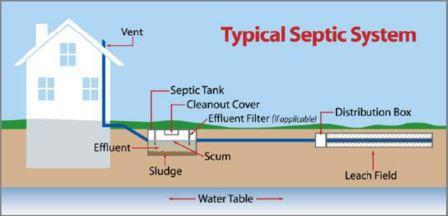How septic tanks work
Your septic tank will treat domestic sewage and waste water by allowing bacteria to naturally break down potentially harmful substances.
In order to work effectively the sewage and waste water should stay in the tank long enough for the bacteria to do their work.
The solids will settle to the bottom of the tank and what comes out of the tank should be a clear liquid, with no offensive smell. Factors such as temperature, the amount of liquid entering the tank, and chemicals in the waste water can affect how well the tank performs. This liquid does contain the breakdown products of the bacterial action, so contains chemicals such as nitrates and phosphates, as well as any other chemicals that can’t be broken down.
The solids that settle will eventually need to be removed, so to keep a septic tank working effectively regular desludging should be carried out.
Usually the liquid discharge from the tank will be directed into a drainage field, often referred to as a “soakaway”. This is a network of pipes buried under the soil where the liquid discharge soaks into the soil. Here it is further broken down by soil bacteria and is taken up by plants as nutrients. It is important that the soil conditions are right for a soakaway, or problems can arise.

Figure 1 Typical septic tank
In some cases, where the soil is too shallow, or where the water table is too close to the surface, a raised mound of soil can be used. This can be expensive; it may need significant amounts of soil to be imported, and could need a pump to be installed to get the waste water into the mound. Well drained soil with more than 2 metres of soil above the water table is the best option.
If no ground is suitable for a soakaway then the outflow from the septic tank will need further treatment before entering a watercourse. This could be done using a package treatment plant, or biological filters. Discharges can also be further treated using a properly constructed reed bed, or by using a gravel filter. Both these options will require a large area of ground.
A properly constructed soakaway is the best option for dealing with the discharge from your septic tank.
Further information
Scotland: Where does my sewage go? fact sheet
